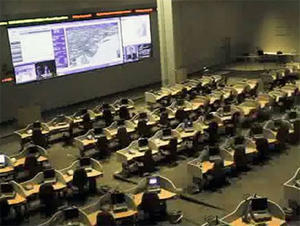DHS intelligenceBipartisan panel calls for local emphasis in DHS intelligence
A new report by a bipartisan group of security experts argues that DHS should shift its intelligence gathering efforts away from foreign enemies and focus on local threats by working with law enforcement agencies and the private sector to secure critical infrastructure, the border, and cities from domestic threats

A DHS - Local Intelligence Fusion Center // Source: dhs.gov
A new report by a bipartisan group of security experts argues that DHS should shift its intelligence gathering efforts away from foreign enemies and focus on local threats by working with law enforcement agencies and the private sector to secure critical infrastructure, the border, and cities from domestic threats.
The report, titled “Homeland Security and Intelligence: Next Steps in Evolving the Mission,” was published by the Aspen Homeland Security Group, which is co-chaired by former DHS Secretary Michael Chertoff.
“Though the impetus for creating [DHS], in the wake of the 9/11 attacks, was clearly terrorism based, the kinds of tools now deployed, from border security to cyber protection, are equally critical in fights against emerging adversaries,” the report said.
In the decade since 9/11, domestic threats to the United States have grown to include drug cartels, organized crime, hackers, as well as terrorism. As a result, “DHS intelligence mission should be threat agnostic,” the authors write.
With a slew of intelligence agencies with similar missions safeguarding the United States, the report posits that DHS should avoid competing with other agencies and overlapping responsibilities, instead focusing on its areas of core strengths – analysis and the dissemination of critical intelligence to local law enforcement agency, the private sector, and critical infrastructure operators.
“There are enough agencies pursuing the terrorist adversary to allow DHS to build a new analytic foundation that emphasizes data, analytic questions, and customer groups that are not the focus for other agencies,” the report states.
“Analysis that helps private-sector partners better understand how to mitigate threats to infrastructure, for example, should win more resourcing than a focus on all-source analysis of general threats, such as work on assessing the perpetrators of attacks. Conversely, all-source analysis of terrorist groups and general terrorist trends should remain the domain of other intelligence agencies.”
In particular, the report urges DHS to focus on the areas presently underserved by other intelligence areas, the state and local level. Moreover DHS should aim to broadly disseminate unclassified information so local law enforcement agencies, emergency management officials, and private sector partners can all be kept in the loop on emerging threats at the local level.
As an example, the report points to the aftermath of the Mumbai attacks where DHS intelligence could have partnered with private sector security officials in the hospital, hotel, and port industries to bolster security measures.
More specifically, the report said DHS could have created “unclassified graphics and text explaining how the terrorists entered ports; how they breached perimeter security at facilities in the city; how security within facilities struggled during the ensuing battle; and how the attacks compared with other attacks in recent years against public buildings.”
In addition this information should be made publically available so all organizations involved in engineering, building security, or port security would have the opportunity to see it and learn from it.
The report concludes, “This new approach to intelligence — serving local partners’ requirements, providing intelligence in areas (such as infrastructure) not previously served by intelligence agencies, and disseminating information by new means — reflects a transition in how Americans perceive national security.“
